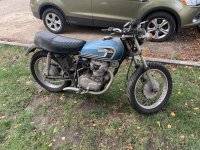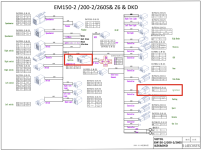RealPolarBear
1 mW
Hello everyone!
I am relatively new to this community and am super excited to learn about electric motorcycle conversions. I have been lurking for a bit to compile a parts list of my own to start my first build. I have done smaller projects with RC cars and electric skateboards so I am familiar with some of the main components that go into a build, but I am looking for more advice.
The motorcycle I’m converting is a 1974 Honda CB360 which came mostly complete (with a non-running motor). The frame, wheels, tires, fork, and swingarm weigh roughly 150-175 lbs (68 - 79 kg). I myself am a 6’ 3” 190 lbs (190.5 cm 86 kg) rider. I would like to be able to cruise at ~55 mph (~88 kph) and do short (<30s) bursts quicker. This bike will be a road commuter where the speed limit doesn’t exceed 45 mph around town. That being said, it would be nice to be able to have some overhead to ride back roads where the speed limit increases to 55 mph. It should be noted that around town, the roads are relatively flat, but outside of town, it can get hilly with inclines at 5-6 degrees (8-11%). These hills are 1 mile long at the VERY most. Usually, they are about half a mile. I would like to have at least 20 miles (32 km) of range around town. Likely, I am probably just going to get a battery that fills the frame well (capacity-wise), so the exact numbers on range are not too important to me. 20 miles just seems like a reasonable minimum.
From snooping around the forums for a bit, I have learned an enormous amount and have started to compile a parts list. I would be very grateful to anyone who can offer any criticism to this list as this is a new experience for me.
Parts:
Motor: QSMOTOR 138 4000W V3 Mid Drive Motor With Gearbox
Controller: SiAECOSYS/VOTOL Programmable EM200-2sp 72V 600A Controller
Battery: Amorge Custom 72v 40ah 200A battery pack with charge indicator
Of course there will be accessories and smaller parts here and there, but currently, I am more concerned with the big expenditures. My budget for the three of these items is about $1700 but I have some wiggle room.
My main questions are:
Controller: Is the VOTOL EM200-2sp a reasonable controller for this build? It is rated at 72 v (which is what I will be running at) and 200 A with boosts capable of 600 A. I am also considering a Fardriver. Would this be a better option? If so, are there any recommendations for a specific controller?
Battery: The Ah are not too important to be right now, I’m more concerned with amps. I believe I should be looking at a battery rated at 200 A with boosts of 240 A. Will this be able to push me up to speed of 50 mph (80 kph) in a reasonable time (<15s)? Or should I be looking to get a battery with higher discharge than this? If so, what are some recommendations that I can ask Amorge for that will be safe on the VOTOL or Fardriver recommendations?
Any feedback and advice y’all have to offer would be extremely appreciated. Thank you in advance
I am relatively new to this community and am super excited to learn about electric motorcycle conversions. I have been lurking for a bit to compile a parts list of my own to start my first build. I have done smaller projects with RC cars and electric skateboards so I am familiar with some of the main components that go into a build, but I am looking for more advice.
The motorcycle I’m converting is a 1974 Honda CB360 which came mostly complete (with a non-running motor). The frame, wheels, tires, fork, and swingarm weigh roughly 150-175 lbs (68 - 79 kg). I myself am a 6’ 3” 190 lbs (190.5 cm 86 kg) rider. I would like to be able to cruise at ~55 mph (~88 kph) and do short (<30s) bursts quicker. This bike will be a road commuter where the speed limit doesn’t exceed 45 mph around town. That being said, it would be nice to be able to have some overhead to ride back roads where the speed limit increases to 55 mph. It should be noted that around town, the roads are relatively flat, but outside of town, it can get hilly with inclines at 5-6 degrees (8-11%). These hills are 1 mile long at the VERY most. Usually, they are about half a mile. I would like to have at least 20 miles (32 km) of range around town. Likely, I am probably just going to get a battery that fills the frame well (capacity-wise), so the exact numbers on range are not too important to me. 20 miles just seems like a reasonable minimum.
From snooping around the forums for a bit, I have learned an enormous amount and have started to compile a parts list. I would be very grateful to anyone who can offer any criticism to this list as this is a new experience for me.
Parts:
Motor: QSMOTOR 138 4000W V3 Mid Drive Motor With Gearbox
Controller: SiAECOSYS/VOTOL Programmable EM200-2sp 72V 600A Controller
Battery: Amorge Custom 72v 40ah 200A battery pack with charge indicator
Of course there will be accessories and smaller parts here and there, but currently, I am more concerned with the big expenditures. My budget for the three of these items is about $1700 but I have some wiggle room.
My main questions are:
Controller: Is the VOTOL EM200-2sp a reasonable controller for this build? It is rated at 72 v (which is what I will be running at) and 200 A with boosts capable of 600 A. I am also considering a Fardriver. Would this be a better option? If so, are there any recommendations for a specific controller?
Battery: The Ah are not too important to be right now, I’m more concerned with amps. I believe I should be looking at a battery rated at 200 A with boosts of 240 A. Will this be able to push me up to speed of 50 mph (80 kph) in a reasonable time (<15s)? Or should I be looking to get a battery with higher discharge than this? If so, what are some recommendations that I can ask Amorge for that will be safe on the VOTOL or Fardriver recommendations?
Any feedback and advice y’all have to offer would be extremely appreciated. Thank you in advance





